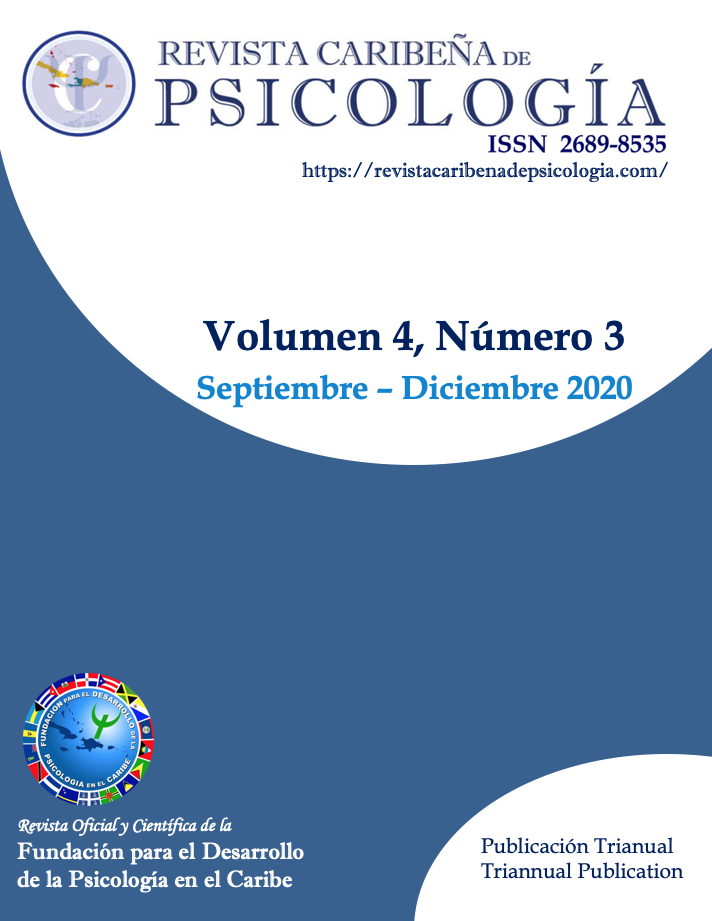Experiences of marital rape in Puerto Rican adult women: A phenomenological study
DOI:
https://doi.org/10.37226/rcp.v4i3.4845Keywords:
couple, patriarchal terrorism, marital rape, violenceAbstract
Marital rape (MR)is one of the manifestations of domestic violence most harmful to women's physical and emotional health. This research explored the meaning of the experience of marital rape suffered by Puerto Rican adult women in past relationships. In addition, the emotional coping and resistance strategies expressed by the participants in their experience of sexual assault are described. The research had a qualitative method with a phenomenological approach. The participants were eight Puerto Rican women, recruited by availability, who survived experiences of marital sexual rape. A semi-structured interview was used to gather the information. The narrative data was analyzed using Wolcott's method (1994). Three categories emerged from the qualitative analysis. It is concluded that MR is a phenomenon inserted within complex relationships of domestic violence, which elicits consequences and significance associated with the cycle of domestic violence and trauma. It is further concluded that gender educational processes are still required that undermine women's ideas of subordination as a possible ideological basis for sexual victimization.
References
Adams-Clark, A.A. & Chrisler, J.C. (2018). What constitutes rape? The Effect of marital status and type of sexual act on percep-tions of rape scenarios. Violence Against Women, 24(16), 1867-1886. https://doi.org/10.1177%2F1077801218755975
Antai, D. (2011). Controlling behavior, power relations within intimate relationships and intimate partner physical and sex-ual violence against women in Nigeria. MC Public Health, 11(2), 1-11. https://doi.org/10.1186/1471-2458-11-511
Bagwell-Gray, M, Messin, J. T. & Baldwing-White, A. (2015). In-timate partner sexual violence: A review of terms, definitions and prevalence. Trauma, Violence & Abuse, 16(1), 1-20. https://doi.org/10.1177%2F1524838014557290
Basile, K.C., Smith, S.G., Liu, Y., Kresnow, M.J., Fasula, A.M., Gilbert, L. & Ghen, J. (2018). Rape-related pregnancy and as-sociation with reproductive coercion in the U.S. American Journal of Preventive Medicine, 55(6), 770-776. https://dx.doi.org/10.1016%2Fj.amepre.2018.07.028
Breiding, M. J., Smith, S. G., Basile, K.C., Walters, M. L., Chen, J. y Merrick, M. T. (2014). Prevalence and characteristics of sexu-al violence, stalking, and intimate partner violence victimiza-tion: National intimate partner and sexual violence survey in United States, 2011. Morbidity and mortality weekly report. Sur-veillance summaries (Washington, D.C. : 2002), 63(8), 1–18. http://www.ncbi.nlm.nih.gov/pmc/articles/pmc4692457/
Buss, D. M., Larsen, R. J., Western, D. & Semmelroth, J. (1992). Sex differences in jealousy: Evolution, pshysiology and psycholo-gy. Psychological Science, 3(4), 25-255. https://doi.org/10.1111%2Fj.1467-9280.1992.tb00038.x
CAAV (Centro de Ayuda a Víctimas de Violación) (2015). Perfil estadístico del Centro de Ayuda a Víctimas de Violación. Departa-mento de Salud.
Tedeshi, R. G. & Moore, B.A. (2016). The posttraumatic growth workbook: Coming through trauma wiser, stronger, and more resili-ent. New Harbinger Publications.
Campbell, R., Dworkin, E. & Cabral, G. (2009). An ecological mod-el of the impact of sexual assault on women’s mental health. Trauma, Violence, Abuse, 10(3), 225-246. https://doi.org/10.1177/1524838009334456
Catalano, S., Smith, E., Snyder, H. & Rand, M. (2009). Female vic-tims of violence. http://bjs.ojp.usdoj.gov/content/pub/pdf/fvv.pdf
Cresswell, J. W. (2003). Research design: Qualitative, quantitative and mixed methods approaches (2nd Edition). Sage Publications.
Finkelhord, D. & Yllo, K. (1982). Forced sex in marriage: A prelimi-nary research report. Crime and Delinquency, 28, 459-478. https://doi.org/10.1177%2F001112878202800306
Friedman, S. H., Loue, S., Heaphy, E. L. G. & Méndez, N. (2009). Intimate partner violence victimization and perpetration by Puerto Rican women with severe mental illness. Community Mental Health Journal, 47(2), 156-163. https://doi.org/10.1007/s10597-009-9270-z
Johnson, M. P. (1995). Patriarchal terrorism and common couple violence: two forms of violence against women. Journal of Marriage and the Family, 57, 283-294. https://doi.org/10.2307/353683
Johnson, M. P., Leone, J. M. & Xu, Y. (2014). Intimate terrorism and situational couple violence in general surveys: Ex-spouses required. Violence against Women, 20(2) 186–207. https://doi.org/10.1177/1077801214521324
Knudson, D. (1987). “Que nadie se entere: La esposa maltratada en Puerto Rico. En Y. Azise Vargas (Ed.), La mujer en Puerto Rico: Ensayos de Investigación. (p. 139-153). Ediciones Huracán.
Lazar, R. (2010). Negotiating sex: The legal construct of consent in cases of wife rape in Ontario, Canada. Canadian Journal of Women & the Law, 22(2), 329-363. https://www.muse.jhu.edu/article/409073
Ley #54 para la prevención e intervención con la Violencia Doméstica. (1989). Gobierno de Puerto Rico. http://www2.pr.gov/agencias/mujer/Pages/default.aspx
Love, H.A., Spencer, C.M., May, S.A., Mendez, M. & Smith, S.M. (2018). Perpetrator risk markers for intimate terrorism and sit-uational couple violence: A meta-analysis. Trauma, Violence & Abuse. https://doi.org/10.1177%2F1524838018801331
Lucca Irrisarry, N. y Berríos Rivera, R. (2009). Investigación cualitativa: Fundamentos, diseños y estrategias (2da. Edición). Ediciones SM.
Mahoney, P. (1999). High rape chronicity and low rates of help-seeking among wife rape survivors in a nonclinical sample: Implications for research and practice. Violence Against Wom-en, 5(9), 993-1018. https://doi.org/10.1177%2F10778019922181590
Mahoney, P. & Williams, L.M. (1998). Sexual assault in marriage: Prevalence, consequences and treatment of wife rape. En J.L. Jasin-ski & L.M. Williams (Eds.), Partner violence: A comprehensive re-view of 20 years of research. Sage.
Martin, E. K., Taft, C. T. & Resick, P. A. (2007). A review of mari-tal rape. Aggression and Violent Behavior, 12, 329-347. https://doi.org/10.1016/j.avb.2006.10.003
Martín Sánchez, M., RFey Martín, A. y Serrano, A.L. (2018). Estudio integral de la violencia de género. Prámide.
Mengo, C., Okumu, M., Ombayo, B., Shamsun, N. & Small, E. (2019). Marital rape and HIV Risk in Uganda: The impact of women's empowerment factors. Violence Against Women, 25(15), 1783-1805. https://doi.org/10.1177/1077801218821444
Muehlemhard, C. L. & Kimes, L.A. (1999). The social construction of violence: The case of sexual and domestic violence. Person-ality and Social Psychology Review, 3, 234-245. https://doi.org/10.1207%2Fs15327957pspr0303_6
National Violence Against Women Prevention Research Center (2016). General information. http://www.musc.edu/vawprevention/
Osborn, K., Davis, J. P., Button, S., & Foster, J. (2018). Juror Deci-sion Making in Acquaintance and Marital Rape: The Influ-ence of Clothing, Alcohol, and Preexisting Stereotypical Atti-tudes. Journal of interpersonal violence, 886260518768566. Ad-vance online publication. https://doi.org/10.1177/0886260518768566
Padmanabhanunni, A. & Edwards, D. (2016). Rape survivors’ experiences of the Silent Protest: Implications for promoting healing and resilience. Qualitative Health Research, 26(6), 818–829. https://doi.org/10.1177/1049732315573201
Rodríguez-Díaz, G.F., Auger-Cabrera, C., Quintero-Jiménez, N. (2018). Factores internos de resiliencia en una muestra de mujeres residentes de Puerto Rico que han sido víctimas de experiencias de trauma. En R.F. García Robles & S.K. Sayers Montalvo, Resiliencia: Medición de la experiencia interna. Publicaciones Puertorriqueñas.
Russell, D. E. (1982). Rape in marriage. Macmillan Publishing com-pany.
Simonson, K. & Subich, L. M. (1999). Rape perceptions as a func-tion of gender-role traditionally and victim perpetrator asso-ciation. Sex Roles, 40, 617-634. https://doi.org/10.1023/A:1018844231555
Snipes, D.J., Calton, J.M., Green, B.A., Perrin, PB & Bonotsc, E.J. (2017). Rape and Posttraumatic Stress Disorder (PTSD): Ex-amining the mediating role of explicit sex-Power beliefs for men Versus women. Journal of Interpersonal Violence, 32(16), 2453-2470. https://doi.org/10.1177/0886260515592618
Walker, L. E. (1979). The battered woman. Harper & Row.
Walker, L. E. (1984). The battered woman syndrome. Springer Pub-lishing Company.
Walker, L. E. (2009). The battered woman syndrome (2nd edition). Springer.
Wolcott, H. F. (1994). Transforming qualitative data: Description, analysis, and interpretation (3rd Edition). Sage.
Yebisi, O. & Balogun, V. (2017). Marital rape: A tale of two legal systems. Obiter, 38(3), 540-55.
Yllo, K. & Torres, G. (2016). Marital rape: Consent, marriage and social change in global context. Oxford Press.
Published
How to Cite
Issue
Section
License
Copyright (c) 2020 Jose Osvaldo Reyes

This work is licensed under a Creative Commons Attribution 4.0 International License.







